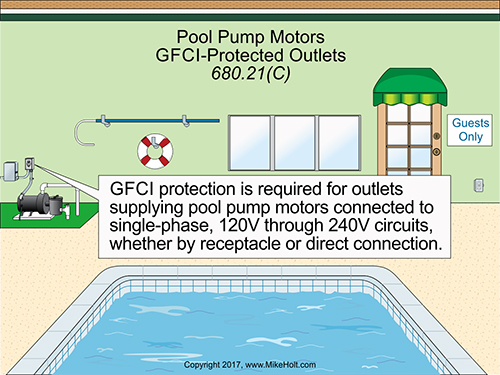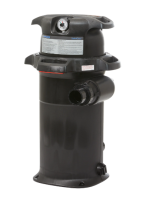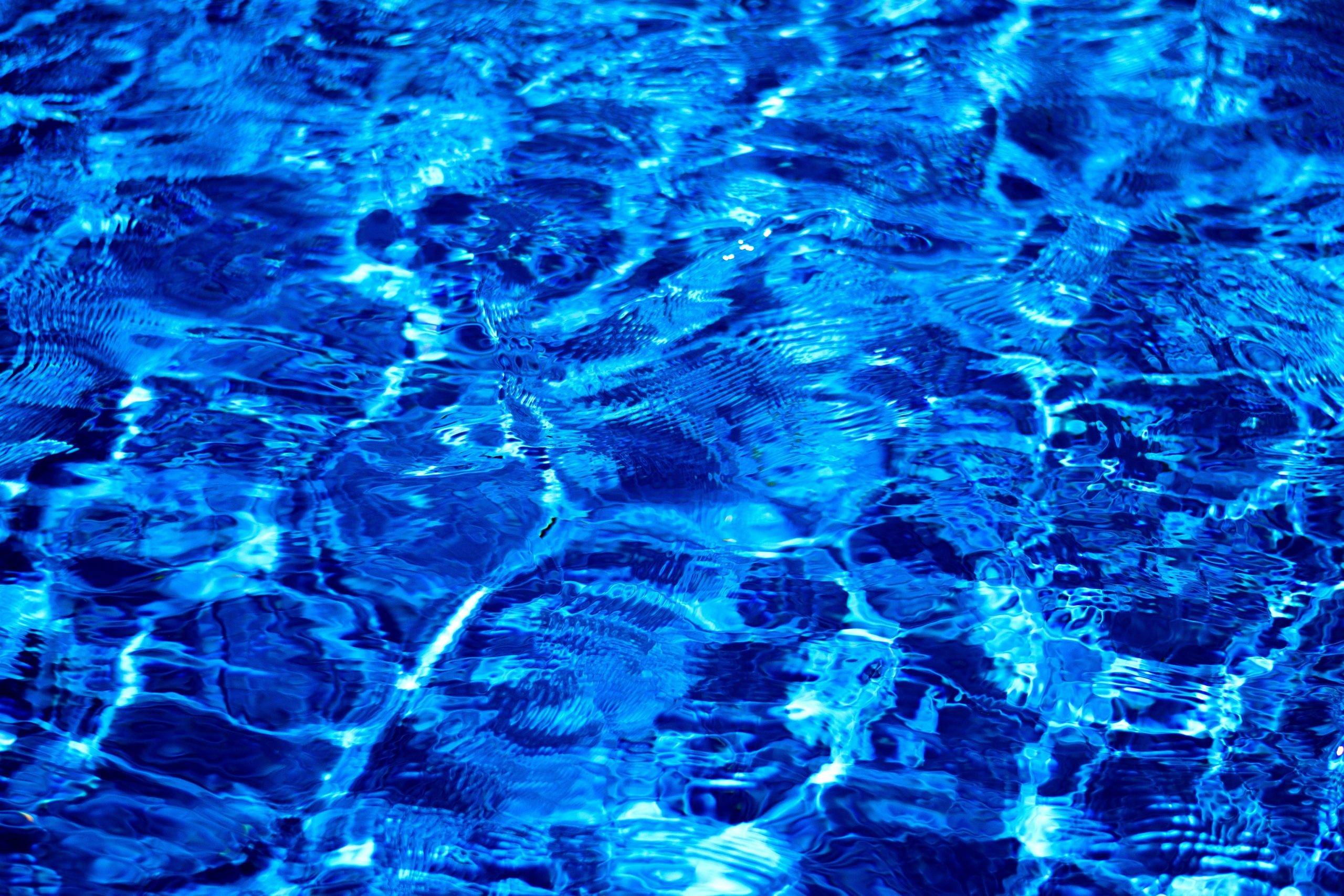contract states one hayward water pump one hayward pool cartridge filter 1 skimmer 2 bottom outlets 4 return jets 1 control panel with timer 300 watt transformer
Need info
- Thread starter enterpriselc
- Start date
You are using an out of date browser. It may not display this or other websites correctly.
You should upgrade or use an alternative browser.
You should upgrade or use an alternative browser.
There is one 110 outlet on east wall that is gfi with a plastic cover and is ten feet away from pool and 3 feet from ground was there when i bought house I use it for my yard trimm blower etcReceptacles
Locate at least one 15A or 20A, 125V receptacle at least 6 ft and not more than 20 ft from the inside wall of the pool [680.22(A)(1)]. This receptacle can't be more than 6½ ft above the floor, platform, or grade level serving the pool.
View attachment 625526

Article 680 - Permanently Installed Swimming Pools, based on the 2017 NEC. Part I of II
CLICK HERE to read this article written by Mike Holt for EC&M Magazine. Please share this newsletter.www.mikeholt.com
I have one ten feet away on patio wall east of poolReceptacles
Locate at least one 15A or 20A, 125V receptacle at least 6 ft and not more than 20 ft from the inside wall of the pool [680.22(A)(1)]. This receptacle can't be more than 6½ ft above the floor, platform, or grade level serving the pool.
View attachment 625526

Article 680 - Permanently Installed Swimming Pools, based on the 2017 NEC. Part I of II
CLICK HERE to read this article written by Mike Holt for EC&M Magazine. Please share this newsletter.www.mikeholt.com
contract states one hayward water pump one hayward pool cartridge filter
Ask for specific Make and Model Numbers.1 control panel with timer 300 watt transformer
That type of description is lame and usually means that they are going to stick you with the lowest quality cheapest piece of junk available.
No doubtAsk for specific Make and Model Numbers.
That type of description is lame and usually means that they are going to stick you with the lowest quality cheapest piece of junk available.
Get a variable speed pump and a SWG.
 hayward.com
hayward.com
Pumps
Hayward pumps are engineered for dependability and performance. Recognized as the industry leader, our line of high performance and medium head pumps lead the way in energy efficiency.
You should find out WHICH Hayward pump they are installing. Hayward has about 10 different models, ranging in retail price from about $250.00 to about $2500.00.contract states one hayward water pump one hayward pool cartridge filter 1 skimmer 2 bottom outlets 4 return jets 1 control panel with timer 300 watt transformer
WHICH Hayward cartridge filter? As you are in Florida, it will likely be very small.
florida and i did ask him he never emaild me back with thatYou should find out WHICH Hayward pump they are installing. Hayward has about 10 different models, ranging in retail price from about $250.00 to about $2500.00.
WHICH Hayward cartridge filter? As you are in Florida, it will likely be very small.
Probably this one.
Shown actual size.


 hayward.com
hayward.com
Shown actual size.


SwimClear Single Element 150 Sq.Ft. Filter
SwimClear single element cartridge filters capture more dirt for superior water clarity without the need of supplemental media or backwashing, while the industry's lowest head loss reduces energy costs.
Last edited:
(3) 10 AWG Conductors and (1) 10 AWG Ground, UF/NMC, 600V, Copper Conductor, PVC Jacket, Gray, 1000 Foot Reel.
Copper UF-B wire is typically used as an underground feeder cable to distribute power from an existing building to outdoor lighting fixtures, pumps, outbuildings and other outdoor equipment.
The cable can also be used as direct burial cable.

• For use underground as a feeder or branch-circuit cable where provided with overcurrent protection of the rated ampacity as specified by the NEC®.
Direct burial in the earth is permitted
• May be installed as interior wiring in wet, dry, or corrosive locations as specified by the NEC®
• May be installed as nonmetallic sheathed cable as specified in NEC® Section 340.10 (4)
• May be installed in locations with temperatures up to 90˚C but with the ampacity limited to that of 60˚C conductors.
Copper UF-B wire is typically used as an underground feeder cable to distribute power from an existing building to outdoor lighting fixtures, pumps, outbuildings and other outdoor equipment.
The cable can also be used as direct burial cable.

• For use underground as a feeder or branch-circuit cable where provided with overcurrent protection of the rated ampacity as specified by the NEC®.
Direct burial in the earth is permitted
• May be installed as interior wiring in wet, dry, or corrosive locations as specified by the NEC®
• May be installed as nonmetallic sheathed cable as specified in NEC® Section 340.10 (4)
• May be installed in locations with temperatures up to 90˚C but with the ampacity limited to that of 60˚C conductors.

Southwire 100 ft. 10/3 Gray Solid CU UF-B W/G Wire 13059123 - The Home Depot
Visit the Home Depot to buy Southwire 100 ft. Gray 10/3 UF-B Cable 13059123
www.homedepot.com
TinFoilHat
Well-known member
@JamesW You are cracking me up bro!
@enterpriselc Are you burying any of this wire? That requires a whole other bunch of regulations to be followed. How deep to bury it, how to protect it, type of wire, etc.
@enterpriselc Are you burying any of this wire? That requires a whole other bunch of regulations to be followed. How deep to bury it, how to protect it, type of wire, etc.
- Nov 23, 2014
- 213
- Pool Size
- 16000
- Surface
- Plaster
- Chlorine
- Salt Water Generator
- SWG Type
- Hayward Aqua Rite (T-15)
Just my opinion but I think one day (soon) you'll regret not at least wiring for a future heater, rendering lesser wiring plans a waste/throwaway. Absent a heater, even in Florida you'll be limited to 4-6 months comfortable swimming - in water at least 80, preferably 85F. I'm far South (Naples) with a south-facing pool and no obstructions and I start using the heater to bring it back up to at least 82, preferably 85 in Sept & Oct, and again it's needed in the spring around March/April/May, always weather dependent. But even with the heater, we only heat the pool to extend the swim season. When the cost to run the heater exceeds about $150 per month we stop swimming, and that's almost always the complete months of Nov/Dec and Jan/Feb (except for special parties or occasions with guests). Unless of course you love icy cold water and/or only plan to swim for a few months in the summer. But it is really nice to have the heater for those special guests and occasions.I will never get a heater it is a 7x15 4 feet deep sun will heat it just fine
Wiring for a single 120V 60 Amp service seems almost absurd to me, or at least very unusual. I realize you're trying to be budget conscious, but I would plan for a 220V service that could accommodate a 220V pump, 220V heater and 120V lights. That requires 4 conductors - two for hot lines, one for neutral, one for ECG (equipment grounding conductor). And yes, get at least a two-speed pump or a variable speed. I've found two-speed pumps far more economical and significantly fewer problems than variable speed.
The former owner who had mine built sized up a bit. On mine, for a heater, pump, 300watt light transformer and 3 amp spa blower - an 80 amp breaker in the main panel feeds a subpanel 40 feet away on an exterior wall by the equipment pad, which is a commonly deployed plan. In this case two #4 THHN wires are the hot lines, one #6 is the neutral and one #8 is the ECG. Those 4 wires are in rigid sch40 conduit from main panel to subpanel. Separate from the actual subpanel breaker sizes specified in owners manuals, the contractor should he adhering to NEC for sizing the wires, usually based on known actual maximum simultaneous loads. Depending on the chosen pump, it may draw from 10-20 amps (in some cases 17-20 on high when vacuuming, etc). Many heaters draw 25-30 amps, and your 300 watt transformer maxes out at a few amps. That totals 53 amps, we were close on a 60 amp circuit - so I guess they sized up to 80. There are rules and tools for all that including percentages to size up from those load currents, rules for the corresponding neutral and ECG, I can't quote each.
You may want to also question the contractor about their knowledge of pool bonding requirements, a good thing to consider for anyone building a pool. Bonding is not a simple thing, and if they tend to blow off the answer you may decide it's the wrong contractor for the job. If you wish, see also Bonding Info from Mike Holt for more on bonding, also many threads here in TFP.
Happy swimming. Eegads - my pool is 60F this morning. Time to leap on in?
TFP is a registered 501(c)3 non-profit that is maintained by user donations.
All of our content is free of advertisements.
Please consider donating at:

 www.troublefreepool.com
www.troublefreepool.com
All of our content is free of advertisements.
Please consider donating at:

Become a TFP Supporter
Help Support TFP Trouble Free Pool is run by a dedicated group of volunteers that … Read more…
thrystan
Active member
I would go with 6 gauge 4 conductor so you will have enough capacity for future upgrades you might make. However at a minimum have the builder install large enough conduit that you can install 4 6 gauge wires in the future even if you install less capacity now. Conduit is pretty cheap so you can future proof the install for a minimal additional cost. My pool was built in the 70s and only has a 30 amp feed and the conduit is too small to upgrade the feed. So I'm going to have to replace the conduit, which is a lot more work than just pulling new wires. When I get around to replacing the conduit I will also be installing a low voltage conduit for a network cable because I avoid WiFi if I have a choice to use wired connections and because I built my own automation and set it up to use wired Ethernet rather than WiFi.
Thread Status
Hello , This thread has been inactive for over 60 days. New postings here are unlikely to be seen or responded to by other members. For better visibility, consider Starting A New Thread.



